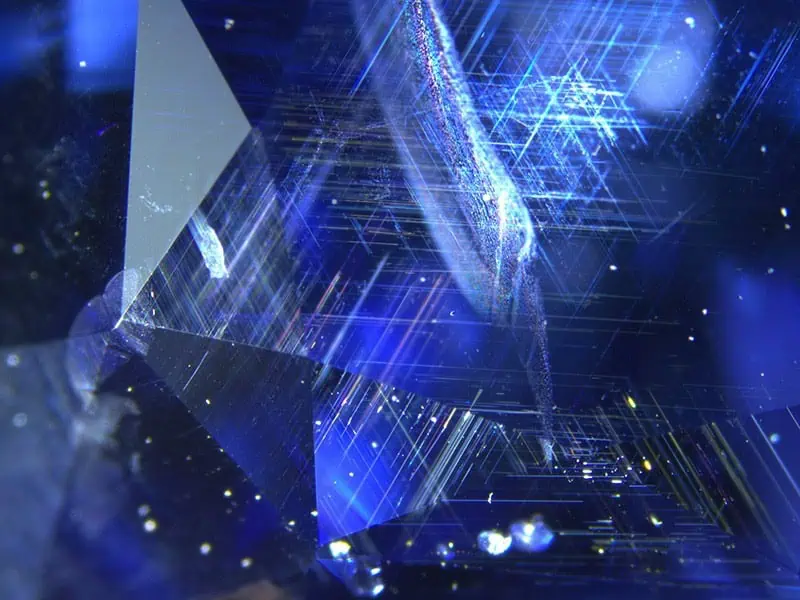Gemmological sapphire appraisal for jewelry and sapphires

Would you like to have your sapphire jewelry or sapphires valued?
Sapphires are a fascinating spectacle of nature and an expression of its boundless creativity. The best-known and most popular sapphires are blue varieties such as the light blue sapphire “Cornflower Blue” or the intense blue sapphire “Royal Blue”.
However, this gemstone is also available in many other color varieties such as yellow, green, pink, purple, orange as well as colorless, color-changing or even as a two- or multi-colored sapphire. Unique color combinations of pink and orange of the padparadscha sapphire are particularly rare.
The different colors of a sapphire are created by traces of different metals and their ratio to each other in the crystalline composition: Titanium and iron produce blue hues, while iron alone produces yellow and green sapphires. Chromium causes pink to red colorations, vanadium leads to violet hues. Like its red variety – the ruby – the sapphire belongs to the corundum group. This mineral is one of the hardest natural gemstones after diamonds.
Which sapphires does the GLA rate?
In our laboratory, we provide independent and objective appraisals of loose sapphires and sapphires that have been used as jewelry. We only examine loose sapphires in cut form. We ask for your understanding that we do not analyze and evaluate rough gemstones.
How is the value of a sapphire determined?
The quality of sapphires is determined – based on the criteria for diamond grading – using the 4 Cs as follows:
- Carat (weight)
- Color (Color)
- Clarity (purity)
- Cut
The value of a sapphire is revealed as soon as you hold this colored gemstone up to the light: Its play of colors should always be vibrant and sparkling, but never too bright or too dark. Color-changing sapphires change color depending on the light source. If the coloration or saturation is too intense, this is referred to as “overcolor”: The color appears dark and opaque and impairs the brilliance of the sapphire. In nature, sapphires are usually purer than rubies or emeralds and have hardly any inclusions. A well-balanced, carefully executed cut brings out the color of the sapphire even better.
What influences the value of sapphires?
Eye-clean sapphires – such as those found in Sri Lanka (Ceylon) and Myanmar (Burma) – have hardly any inclusions and are particularly sought after. Rarities such as velvety blue sapphires from Kashmir or the padparadscha sapphire with its pink-orange play of colors fetch top prices on the gemstone market. Sapphires are often thermally treated to improve their color and purity.
The following factors reduce the value of a sapphire or your sapphire jewelry:
- Visible and numerous inclusions
- Artificial treatments such as heating
- Damage and signs of wear
GLA – Your partner for sapphire appraisals
Artificially produced sapphires – so-called synthetics – have also been traded on the international gemstone market for over 100 years. Sapphire synthetics can only rarely be distinguished from natural sapphires with a magnifying glass alone. Inclusion diagnostics, spectrometry (e.g. FT-IR, UV-VIS-NIR, ED-XRF) and fluorescence appearance are used for this analysis.
Auction houses as well as renowned gemstone dealers usually have the authenticity of gemstones confirmed in a gemological report before they are bought or sold. Adeline Lageder is an industry expert whose reports are in demand internationally. Since 2010, the sworn and court-certified expert has been preparing appraisals for diamonds and colored gemstones such as sapphires for the Gemmological Laboratory Austria, which was founded in Vienna in 1979.

This is how your sapphire appraisal is carried out:
Our state-of-the-art laboratory is equipped with a wide range of instruments that enable analysis according to scientific criteria. Weight and dimensions, color, purity, cut (type, shape, quality) as well as possible treatments, damage and other value-reducing defects of the sapphire are analyzed.
Inclusion diagnostics and other analytical methods usually allow the location of the sapphire to be narrowed down to a specific region. Myanmar (Burma), Sri Lanka (Ceylon) and Kashmir have established themselves as historically important locations. More recent locations include Australia, Madagascar, Pakistan and the USA (Montana).
The GLA has developed its own grading system for colored gemstones in order to objectively determine the quality of sapphires. By comparing internal laboratory and international price lists with current trends in the gemstone market, we can determine the value of your desired trade grade. We are proud that our grading system is recognized by courts, banks and insurance companies and enjoys the trust of well-known auction houses and gemstone dealers at home and abroad.
We will be happy to provide you with a free initial consultation.
Make an appointment for your sapphire appraisal now!
